I get a lot of hyper-specific eCommerce marketing questions, e.g. “should I advertise on Reddit?” or “how do I hire someone to do link building?” or “I just chose my eCommerce store platform and want to try OutBrain or maybe Snapchat or Instagram to get started.” They are great in a way – I’m a huge fan of experimentation and improvement.
But most online store owners haven’t developed an effective inbound* marketing strategy at all. It’s all ad hoc and “shooting from the hip”. They miss the forest (how everything works) for the trees (tactics), so to speak.
*Inbound = the industry jargon for marketing that focuses on being where your customers are so that they buy from you “naturally.” Inbound marketing contrasts with outbound marketing, which focuses on finding, interrupting, and cold-pitching potential customers.
Here’s the exact inbound marketing strategy for eCommerce that I recommend to every reader and client I’ve ever worked with. The specific details vary, but it’s a pretty tried and true path for nearly every online store. I’m focusing on eCommerce but 80% of this applies to every business.
Definitions & Business Goals
Before you decide to do anything, you have to figure out what you have, what you want, and who you are going to market to.
This part of the strategy can be a big slowdown for people, so many action-oriented people immediately jump to trying stuff. That is true, but there’s a balance. It’s just as important to shoot in the right direction as it is to pull the trigger once you’re generally right.
There’s 3 things that you have to figure out. You can figure all of them out simultaneously or in any sequence, but you do have to have a general idea of your product offering, marketing personas and revenue goals.
Product
What are you offering? What’s your brand? What do you have access to that’s different in any way?
Remember, you’re defining your product offering, not your grand life mission. Your product offering needs to be simple, clear, and straightforward. Your offering should be something that is different in some way – ie, a competitor shouldn’t be able to copy + paste and be you.
For example, don’t sell swimwear that “looks great and is affordable.” Instead, sell swimwear that is lightweight in the water. Sell the tangible benefit.
Personas
Personas are the foundation of marketing. Personas are the process of developing a composite of your ideal customer. You can read very in-depth guides to personas, but you can also keep it short, simple, and straightforward.
Outline the wants, needs, likes, dislikes, habits, and information of someone you think would definitely buy your product offering. Outline where they hang out, what they read, who they pay attention to, etc. Don’t just armchair imagine this – go browsing online and find specific sites and stores that they visit (if you need ideas – read this, this and this).
Make 2 to 4 very specific personas. Remember that your initial market is not your total market. Even if you want to build a global brand, that doesn’t mean starting out trying to sell to the world.
Your initial target market/persona is simply your initial market. It’s small enough that you can effectively reach them but big enough that you can get some sales and feedback to polish your product and brand while rolling out to a bigger market. Nearly every business started this way. Think about how Facebook started with college students. Here’s a solid podcast episode explaining this concept [skip to the ~11 minute mark].
Use your product to figure out your persona. If you are selling lightweight swimwear – who is likely to buy it? And of those people, what problems do they have? What are they missing from their current choices? What else do they do?
Let’s stay with the lightweight swimwear example. Ok – suppose your figure out that the typical buyer is an open-ocean swimmer. Take that and figure out what they are missing. They probably don’t feel that their needs are met by clothing shops or outdoor stores like REI. Figure out what those problems are and solve them with every piece of your store. You might find that they are also fans of stand-up paddleboarding or triathlons or Gabby Reece. Those are the interests that you’ll target on Facebook and your site with your content.
Revenue
You have to put real money goals in place. Even if you feel like your budget is arbitrary…you still need a budget if only to give yourself some sort of frame of reference. Outline all your product costs, profit margins, and what kind of marketing spend gives you a positive return. Here’s a more extensive post on “quant-based marketing.”
Structure, Analysis & Data Collection
Now that you have an idea of what you are marketing, who you are marketing to, and how valuable that marketing is – it’s time to get a good foundation in place.
Like setting definitions and business goals, this part of the process can slow things down. But they don’t have to, as long as you keep the end goal in mind, which is:
To get and accurately measure enough conversions (aka sales) to fund and improve your product offering, personas and revenue.
Setting Up Your Website
To sell anything online, you need a website to sell from. If you are going super-lean, you can sell from a marketplace like eBay, Amazon or Etsy. All you need is a profile. The big drawback is that you won’t be able to track your conversions as accurately AND you won’t be building your own brand.
I recommend either using a high-quality hosted eCommerce platform like Shopify or set up an eCommerce website with WordPress and WooCommerce. I built a quiz to find the best eCommerce platform for you here.
All those options will give you a good technical foundation with fast, simple setup. They also allow you to implement a customized off-the-shelf design – “themes.” Themes allow you to have a website that looks good enough to make a sale without spending months and lots of money on a 100% custom design. Creating a store on an established platform also allows you to implement a 100% custom design when that time comes.
Setting Up Goals
The key part of setting up a website, though, is analytics. There are a lot of options, but Google Analytics is the go-to solution (also – free).
The key is to make sure you have an eCommerce checkout setup. Make sure it’s a goal. Make sure the whole package is working correctly because you have to accurately track conversions (aka sales or email opt-ins).
You should also link Google Analytics to Google Ads and set up a retargeting audience with Google Analytics. And lastly, you should set up a Facebook Ads account and place a retargeting (audience pixel) cookie on your website in addition to every other creepy tracking pixel that you can track nowadays. And learn what exactly Google Analytics does.
I’ll get to why later.
Setting Up Focused Pages
Next, you need to create enough high-quality focused pages to get some sales. In addition to your Home page, About page, FAQ pages, and Privacy page, you need landing pages.
When I say “landing pages” – don’t think of anything too complex. I’m simply referring to pages that visitors can land on based on their interest and make a purchase. They are meant to “harvest demand” that is already there that matches either organic searches or paid interests.
Why?
Here’s pro tip that few website owners will admit to: nobody cares about or even sees your homepage. Seriously. Your homepage is for people who already know you who are just navigating around.
Landing pages are for new (or returning) visitors to land on and convert. Before you build out all your website pages, you should develop focused landing pages that sell to one or all of these buckets:
Persona specific – These pages are all about the product benefit for who you are selling to. They might be a product page. Think “Aerodynamic Swimcap for Ocean Swimmers.” But they also might be a category page or specific landing page for a bundle. Think “Swimcaps for Women Distance Swimmers” or “One-piece Swimsuits for Ocean Swimmers.”
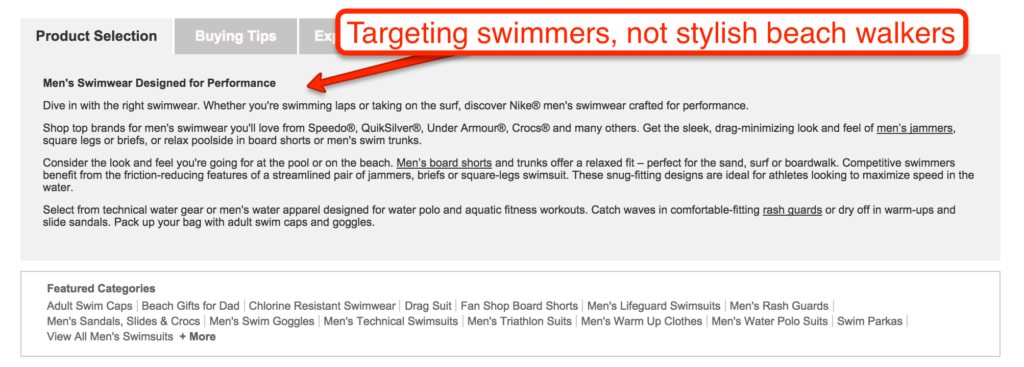
Offer specific – These pages are all about the product information. They might be a product page. Think “Blue Stripe Lycra Two Piece Swimsuit.” But they also might be a category or specific landing page for a bundle. Think “Blue Oceanwear” or “Lycra Swimwear.”
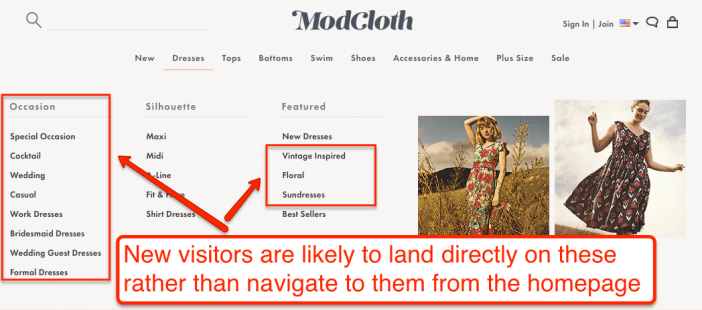
The goal here is to sell to people at the very bottom of the marketing funnel – the customers most likely to convert.
They already know what they want and are ready to buy. These people will be more expensive to bring to your site, but if you can get them there, will give you the best data and most money quickly.
I touch on this idea in my post on keyword mapping because it plays into SEO as well.
Getting Traffic
Now – you have to get people to your website. And this is where a lot of people get way too detailed…way too fast. Why?
Because not all marketing channels operate at the same speed. They also all have different strengths and weaknesses. Think of all marketing channels in terms of complementing or supplementing each other instead of competing. It’s all about how you put it together.
For example, the US Navy’s main wargoing unit is the Aircraft Carrier Group. But it’s not just made up of an aircraft carrier. Instead, it’s a grouping of different types of ships that all do different things at different speeds so that the whole group together is nearly invincible.
A lot of eCommerce owners want to start with SEO or with a fully fleshed out social strategy. To keep to the analogy, that’s like sending your battleship and aircraft carrier to scout out for the rest of the group.
Bad idea. Battleships (aka SEO) and Aircraft Carriers (Social) take forever to get going and to turn. Save those until you know where you’re going. You do not want to invest hours and hours and tons of resources and thought into SEO and Social if you have no idea if they will pay off.
Start with channels that can speed up, slow down and change direction at will. That means 2 things: direct outreach and paid traffic, specifically the Google Ads Search Network.
Direct Outreach
I call this channel direct outreach, but other people would call it just hustlin’. This channel consists of all the tedious and tough pitching that you know you need to do…but don’t want to do.
This means emailing and Facebook messaging people that you know might be interested. And sending them to your landing pages to buy or subscribe to an email list (for discounts, etc).
Check out this case study or this post for even more detail.
Paid Traffic
Yes, “inbound marketing” is usually associated with getting people to your website for “free.”
But I think search marketing is a bit of an exception. You are doing inbound marketing – being where your customers are at when they are interested in buying – but you are just paying Google to be at the front of the line.
Google Ads can be expensive for a good return on investment, especially for the close to converting keywords that you should try to buy. But your goal is slightly different.
You are buying data.* Lots of data. And spending some money to acquire this data is a lot more effective than spending tons on an eCommerce content strategy right out of the gate.
*You can also literally buy the data of competitors’ campaigns by signing up for a PPC Advertising Research Tool like SEMrush.
You should be doing a few things with your new traffic.
- Look at what keywords are driving sales. Ads give you this information.
- Look at what landing pages are driving sales.
- Optimize your landing pages.
- Test ad copy and figure out the right messaging.
- Test things like free shipping and other theories.
- Test related products to try to increase average order value.
- Set up retargeting campaigns – not generic “buy, buy, buy” campaigns but interesting retargeting ads that you can afford to do when your traffic is small. If you want to divert some paid budget to Facebook, follow this guide.
- Once you have retargeting campaigns going, look and see where your audience goes online. We covered this topic on this podcast episode.
- Improving your ad campaigns in general
Now that you have some sales and some data, you should have some sense about where to head next.
Organic Search (SEO) Traffic
Organic traffic (SEO) still might not be the best next channel to pursue after paid traffic. There’s a great big wide world of paid and organic traffic sources.
And yet, most website owners do have a strong sense of the sheer volume of traffic that Google organic search can drive. For most, a successful SEO campaign would be a huge win. They just need to execute in the right context.
Google processes more than 3.5 billion queries per day. And for most queries, most of the clicks go to an organic result. And you’ll know from your Ads campaigns that clicks for commercial keywords can be quite expensive. That’s a cost you don’t have to pay if you rank in the organic results.
So I won’t hide my enthusiasm for SEO. It’s my specialty and is the giant battleship that will keep on going once it’s headed in the right direction.
When you are setting your inbound marketing strategy for eCommerce, you have to know what it takes to get organic traffic and what it will take on your part to get it done.
SEO boils down to 3 components:
The first component is technical SEO.
Technical SEO is all about ensuring that Google/Bing bots can crawl and index your website effectively. It’s about making sure you’re not generating tons of duplicate content. Here’s “Technical SEO for Nontechnical Marketers“
The good news is that if you choose a platform like Shopify or a self-hosted store with WordPress + Woocommerce, then you’ll have already solved most all technical issues.
If you are already using a different platform, a technical audit might be the one SEO thing worth paying for. Mentioning a “stand-alone technical audit with recommendations” to an SEO expert can be valuable if you’re on a proprietary platform or something like Magento or Volusion.
If you are running WordPress, install WordPress SEO by Yoast and run through my guide for using it effectively.
If you are using Shopify, then your technical issues are 90% solved if you have it set up by the book (Shopify’s guide). You should just be sure to use their SEO-related toolset to implement your on-page content, which happens to be the second component of SEO.
The second component of SEO – on-page content and optimization – is all about “targeting” the right keywords and ensuring that your website is laid out in a coherent way that is understandable by search engines and users browsing your website.
I wrote about the concept of keyword mapping and some basic on-page SEO concepts (like keyword research, title tags and meta descriptions, and using Google Search Console) previously.
For eCommerce, there are a ton of different pieces of content that can bring in visitors. From Buying Guides to How Tos to Category pages to Product Comparisons to niche topic ideas…even a coupon page – there is near infinite potential to create content around your product and how your target market buys it.

According to Jeremiah Smith –
“The goal here is to completely cover every area of your business with information unique to you and answering the problems of your personas.”
Your content should bring in new people AND support sales. Don’t create keyword-stuffed content that won’t help customers on your website make a decision. Make the authoritative content that addresses problems, questions, etc of your market.
If you have a budget, you can use Semrush to shortcut a lot of the manual work. You can drop in competitor pages or keywords and it will provide achievable ideas.
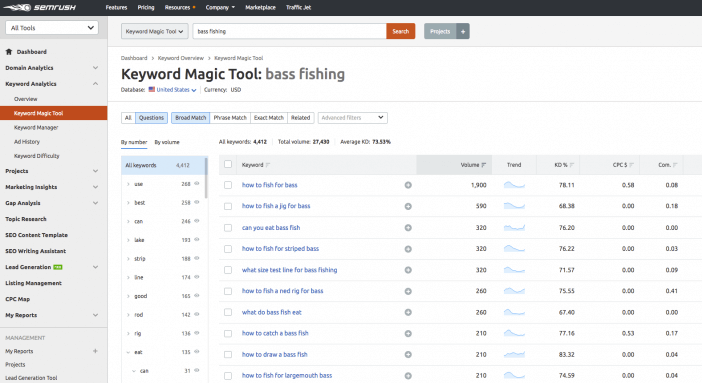
If you are on a budget, you can also substitute KWfinder’s excellent product for this same purpose (though they don’t bundle PPC research like Semrush)
The great part about creating the absolute best content that you can find about everything your target market cares about related to your product is that it will naturally drive the third component of SEO – off-page factors.
Pro-tip: If you want to see on-page content done right, look at REI.com.
“Off-page factors,” the third component of SEO, is SEO-speak for getting links, with the caveat that links are not all considered equal.
Sketchy links, the type that you buy for $5, can harm your website. However, quality links placed on a related or well-known website are the primary factor for getting better visibility in search results.
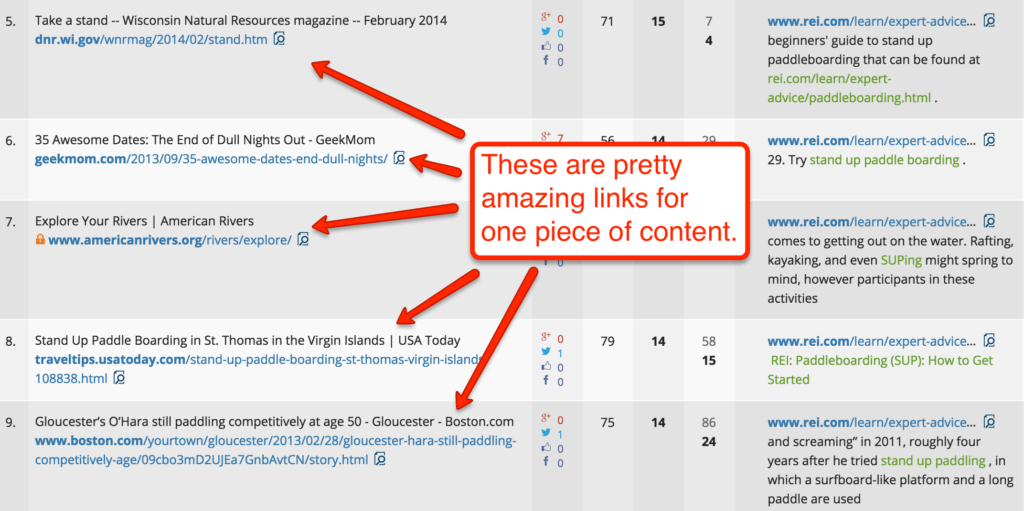
There are a lot of ways to get links. But the best ways that I’ve found for eCommerce are:
- Creating content that no one else has done well, and then promoting it. I wrote this guide to creating prequalified content. I’m a fan of this guide for the promotion angle as well
- Hustle PR promotion – Find the blogs they read. Find the news websites they follow. Find the social media feeds they are involved with. Research and stalk every single one until you can craft a manual email pitch.
- Use Semrush (or SiteProfiler by Mangools for a more affordable alternative) to see what links your competitors have and use it to get even more.
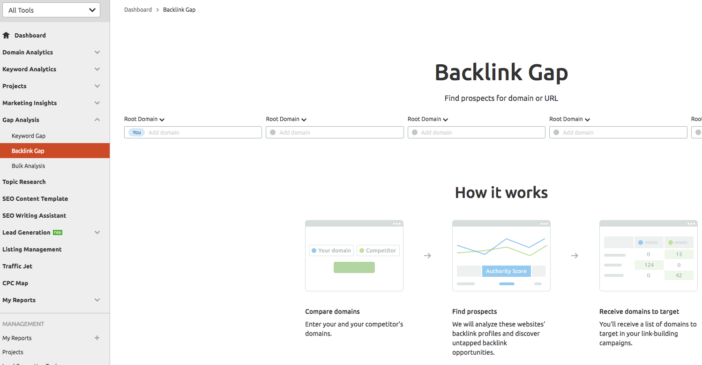
Social Traffic
If SEO is your giant battleship, I think of social as your aircraft carrier. It’s easy to burn a lot of energy flying planes for no reason, but nothing gives you a tactical edge and far reach like your aircraft.
Social media experts make social out to be rocket science. It’s really not. Unless you’ve started a business that you know nothing about…then you should know where your audience hangs out.
And if you know where your audience hangs out, don’t think that you have to be 110% present on every single social network. The key to social media is direct interactions where you build relationships and learn more about your audience.
Sure, claim and put your branding across all the various social networks, but choose the one or two that will generate an outsize impact on sales, links, and awareness.
Learn how to automate the other profiles so that you have a presence even if you aren’t interacting. Set up alerts so that you can “listen” even when you aren’t actively participating.
Lastly, remember that you can pay to jump to the front of the line on social. Just as you used Ads to test keywords before creating content and messaging, you can use social ads to test networks like Pinterest, Snapchat, OutBrain, Amazon, YouTube, Spotify, Instagram or alternative channels.
Next Steps
That’s the inbound marketing strategy that I would map out for any online store. It’s a long post, but it’s a plan that you can implement quickly by breaking each section into small, doable steps.
The final takeaway is that everything you do will conform to the 80/20 Principle. I’ve seen a lot of analytics profiles across a wide range of industries. In every single one, every metric conforms to 80/20.
- 20% of the products make up 80% of sales.
- 20% of content drives 80% of organic traffic.
- 20% of ad spend drives 80% of revenue.
It’s critical that in every step of the process to focus on the 20% that matters, and keep expanding the overall amount of opportunity. Every step of the strategy above can be optimized and subjected to 80/20 analysis.
If you’ve never read much about the concept, check out the original 80/20 Principle by Richard Koch AND the follow-up 80/20 for Sales & Marketing by Perry Marshall.
If you built your online store with Shopify, I wrote a customized guide to getting customers on Shopify.
Immediate next steps – start defining your product offering, personas, and revenue goals.
h/t to Jeremiah Smith’s piece and Noah Kagan’s piece that provided inspiration and resources for this post.



